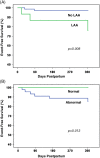Electrocardiographic findings in peripartum cardiomyopathy
- PMID: 30843220
- PMCID: PMC6522992
- DOI: 10.1002/clc.23171
Electrocardiographic findings in peripartum cardiomyopathy
Abstract
Background: There is limited data on electrocardiographic (ECG) abnormalities and their prognostic significance in women with peripartum cardiomyopathy (PPCM). We sought to characterize ECG findings in PPCM and explore the association of ECG findings with myocardial recovery and clinical outcomes.
Hypothesis: We hypothesized that ECG indicators of myocardial remodeling would portend worse systolic function and outcomes.
Methods: Standard 12-lead ECGs were obtained at enrollment in the Investigations of Pregnancy-Associated Cardiomyopathy study and analyzed for 88 women. Left ventricular ejection fraction (LVEF) was measured by echocardiography at baseline, 6 months, and 12 months. Women were followed for clinical events (death, mechanical circulatory support, and/or cardiac transplantation) until 1 year.
Results: Half of women had an "abnormal" ECG, defined as atrial abnormality, ventricular hypertrophy, ST-segment deviation, and/or bundle branch block. Women with left atrial abnormality (LAA) had lower LVEF at 6 months (44% vs 52%, P = 0.02) and 12 months (46% vs 54%, P = 0.03). LAA also predicted decreased event-free survival at 1 year (76% vs 97%, P = 0.008). Neither left ventricular hypertrophy by ECG nor T-wave abnormalities predicted outcomes. A normal ECG was associated with recovery in LVEF to ≥50% (84% vs 49%, P = 0.001) and event-free survival at 1 year (100% vs 85%, P = 0.01).
Conclusions: ECG abnormalities are common in women with PPCM, but a normal ECG does not rule out the presence of PPCM. LAA predicted lower likelihood of myocardial recovery and event-free survival, and a normal ECG predicted favorable event-free survival.
Keywords: electrocardiography; maternal-fetal health; outcomes; peripartum cardiomyopathy.
© 2019 The Authors. Clinical Cardiology published by Wiley Periodicals, Inc.
Figures

References
-
- Honigberg MC, Givertz MM. Peripartum cardiomyopathy. BMJ. 2019;364:k5287. - PubMed
-
- Isezuo SA, Abubakar SA. Epidemiologic profile of peripartum cardiomyopathy in a tertiary care hospital. Ethn. Dis. 2007;17:228‐223. - PubMed
-
- Fett JD, Christie LG, Carrway RD, et al. Five‐year prospective study of the incidence and prognosis of peripartum cardiomyopathy at a single institution. Mayo Clin Proc. 2005;80:1602‐1606. - PubMed
Publication types
MeSH terms
Grants and funding
LinkOut - more resources
Full Text Sources
Medical

